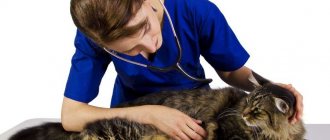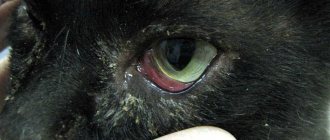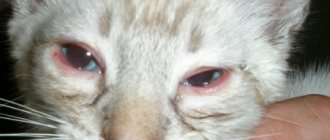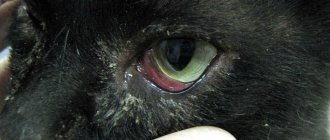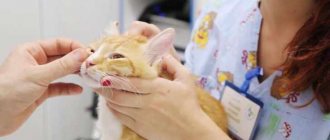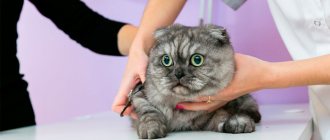When your pet feels unwell, it will not be able to tell its owner how it is feeling. It is necessary to monitor the external condition and behavior of your furry friend daily. Pets are often the target of blepharitis. In cats, this is a fairly common disease of the mucous part of the eye. If you do not respond to lacrimation, the contaminated part of the mucous membrane, you can get serious complications that will result in partial loss of vision and absolute blindness.
Blepharitis in cats: symptoms and treatment
The concept of blepharitis in veterinary medicine
Blepharitis is inflammation of the eyelids. The disease is common to all domestic animals, from dogs to hamsters. Cats are no exception.
Pet owners often confuse blepharitis with ordinary conjunctivitis, which can be treated on their own. However, the use of external solutions, washing with herbal decoctions and applying ointments do not bring the desired result, but, on the contrary, complicate the situation. The animal's condition is deteriorating day by day. In order to diagnose blepharitis in a timely manner, at the slightest suspicion of eye disease, you should see a veterinarian. With prompt intervention and properly selected treatment, this disease is eliminated quite quickly.
Blepharitis is inflammation of the eyelids
Types of blepharitis
There are several varieties of this disease, depending on the form of the disease and the causes of the lesion. Highlight:
- anterior, in which only the edge of the eyelids along the growth of the eyelashes is affected;
- in the posterior case, the meibomian glands are affected;
- angular affects the mucous corners of the eyes.
Table. Main types of blepharitis
| No | View | Description |
| 1 | Simple | It is characterized by redness of the eyelid and thickening at the edges. Purulent discharge accumulates in the corners of the eye. Meibomian glands expand |
| 2 | Scaly | The eyelid is subject to severe swelling and redness. Purulent inflammation forms. White fluid accumulates in the corners of the eyes. Scales appear along the eyelash line, reminiscent of dandruff. Very often complicated by conjunctivitis |
| 3 | Ulcerative | Develops along with the purulent process. Ulcers affect the roots of the hair. The eyelids turn red and swell. Yellowish dandruff appears. When the ulcers are affected, a bleeding ulcer appears. In the absence of a proper response, the development of various pathogens is possible |
| 4 | Demodectic | The cause of this disease is tick infection. The disease is possible due to a weakened immune system. Inflammation appears in the eyelid area. This form is difficult to diagnose and difficult to treat. Most often ends with surgery |
| 5 | Allergic | Redness and swelling of the eyelids, severe itching, aversion to light, lacrimation. The cat behaves restlessly, rubbing its eyes with its paw and on the furniture. Most often occurs due to poor diet or contact with chemicals. |
| 6 | Meibomian | Settles in the meibomian glands. The eyelashes stick together and yellow pus forms on them. A thick white substance and mucus appears in the corners of the eyes |
| 7 | Phlegmonous | Unilateral form of blepharitis. Accompanied by high temperature. There is pus in the corners of the eyes. The tissue on the eyelids becomes scarred. In the absence of a proper response, necrosis occurs |
Video - First signs of eye disease in dogs and cats
Types of disease and symptoms
Since a cat’s blepharitis is a polyetiological disease, the symptoms will differ depending on the type of infection.
Squamous blepharitis
This form of the disease is the most common. At the beginning of the process, redness of the eyelids is noted, their edges become thickened and dense. Where eyelashes grow, gray scales are visible, under which purulent mucus forms. The eyelashes fall out and the eyelids become bare, the eyes constantly water. The cat's face becomes peculiar. She can't look at the light, she squints.
Since purulent discharge irritates the skin of the eyelids, the cat constantly rubs the eyelids with its paw, which further increases the spread of infection, which can spread to the eye tissue and cause purulent conjunctivitis.
Ulcerative blepharitis
It develops as a complication of the scaly form of the disease. When dried purulent crusts fall off, or the animal tears them off with its paws, ulcers form underneath them. Through them another infection penetrates, which complicates the course of the disease. When ulcers scar, the eyelids tighten, which leads to a complication - entropion. Eyelids that are deformed without eyelashes lose their function.
INTERESTING TO FIND OUT: Why does a cat lose teeth?
Meibomian blepharitis
This type of infection develops due to increased secretion of the meibomian glands. Their secretion is involved in the formation of the tear film, which protects the cornea of the eye. With increased secretion, inflammation of the eyelid margin develops, and pathogenic flora penetrates the meibomian glands. The eyelashes stick together and fall out, and purulent crusts form underneath them. There is constant discharge of pus from the eyes.
Demodectic blepharitis
This form of eyelid disease is caused by the ciliated demodectic mite. It is a natural ectoparasite of cats. Normally, it feeds on dead skin scales and does not cause disease. But with a decrease in immunity, in the presence of any infection, the tick begins to actively multiply, and its waste products lead to the development of inflammation of the eyelid.
The edge of the eyelid thickens, white scaly lumps form on the eyelashes, sticking them together. Further development of the process is fraught with the transition of inflammation to the eye tissue. This form of blepharitis is the most difficult to treat.
Allergic blepharitis
The allergic form of the disease can manifest itself as a response to various types of irritants: mechanical, chemical, biological, etc. The disease occurs in an acute form. The eyelids swell and turn red. The eyes become watery and photophobia develops. All forms of blepharitis in cats indicate the presence of some kind of infection in the animal’s body and a decrease in immune strength.
An untreated, chronic form of the disease threatens the animal with fusion of the eyelids, conjunctivitis and loss of vision.
Causes of blepharitis
There are many factors that lead to inflammation of the eyelid margin in pets.
- Among the most common causes are burns, including chemical ones.
- If your pet has recently taken any medications to treat another condition, the medications may have caused this reaction in the eyes.
- Incorrectly selected food can also lead to similar diseases.
- But the most common cause is various mechanical damage to the cornea or eyelids.
- If your cat often goes outside, then you shouldn’t rule out a fungal infection.
- Very often, inflammation appears against the background of renal failure.
In any case, blepharitis does not occur just like that, but is a consequence of serious problems with the pet’s health.
Incorrectly selected food can cause the development of eye diseases in cats.
Going to the veterinarian is not only about prescribing treatment. The doctor must find out the cause in order to prevent relapse in the future. The veterinarian checks whether the inflammation is due to:
- parasitic infestations;
- disturbances in the functioning of the endocrine system;
- autoimmune diseases;
- dysfunction of the sebaceous glands.
Depending on the cause of blepharitis, the symptoms of this disease also differ. Very often, correctly identified symptoms allow you to quickly find out the cause, eliminate the irritating factor and subsequently protect the animal from trouble.
When is it necessary to consult a veterinarian?
In most cases, dermatological diseases in cats are treated at home and do not pose a threat to life. However, there are situations in which mandatory veterinary assistance is required. Sometimes self-treatment of a pet can lead to serious and even tragic consequences. Reasons for visiting a veterinary clinic should be:
- increase in pet's body temperature;
- decreased motor activity and lack of response to external stimuli for a long time (more than 24 hours);
- refusal of food and water;
- inability to rise independently;
- bleeding;
- uncontrollable vomiting;
- diarrhea;
- suppuration in the eye area;
- impaired respiratory function (urgent treatment measures are required if the pet is breathing heavily and wheezing or if its breathing is rapid and shallow);
- blood in urine or stool;
- a plaintive meow for no apparent reason.
Symptoms of blepharitis in cats
Symptoms vary depending on the type of disease. In 80% of cases, veterinarians are faced with redness of the eyelid and its inflammation. Clear or purulent discharge appears in the corners. The pet is nervous and tries to scratch the inflamed area. Such actions are aimed at eliminating itching. Gradually, the size of the eyes begins to decrease, the pet is limited in the viewing angle.
Advanced blepharitis
Against the background of blepharitis, conjunctivitis often begins to develop. Depending on the expression of symptoms, you can understand how long the disease lasts.
Purulent discharge from blepharitis in cats
But, in addition to standard symptoms, there are also specific manifestations. For example, if we are talking about a fungal disease. Cat owners note that against the background of this disease they experience eyelash loss and baldness in the eye area.
If the cause of the disease is autoimmune processes, blistering formations can be found on the cat’s body. In such a situation, a biopsy is required to make a correct diagnosis.
Blistering formations in blepharitis
When inflammation is caused by infection, this is indicated by the animal's painful condition. The cat becomes lethargic, apathetic, eats and drinks practically nothing. As the disease progresses, the animal's body begins to feel feverish. In case of infection, antibacterial therapy should be started immediately.
Veterinarians often encounter scaly blepharitis. With this type, the eyelids turn red and swelling spreads. The edge of the eyelid thickens and becomes dense. Against the background of this process, the shape of the eyes narrows. Gray small scales form in the eyelash growth area, which affect eyelash loss. If the scales begin to fill with pus, then the disease develops into an ulcerative condition. This disease develops much faster. The wounds begin to scar, and the eyelid literally turns in the opposite direction.
Symptoms
Despite the fact that there is one disease, the symptoms of blepharitis in cats are slightly different depending on the type of inflammation. But first, a little about the general ones: itching, lacrimation, swelling and redness of the eyelids. The pet tries to scratch its eye with its paws, and this can only further injure itself.
Squamous blepharitis
The most common type of inflammation. Most often, others develop from it. The eyelids first turn red and swell. The edges become thick and dense. Where the eyelashes grow, you can see grayish scales. Gradually, pus discharge can be seen in their place. Over time, eyelashes fall out.
Ulcerative blepharitis
First, it is scaly blepharitis that develops in cats (photo below). When the crusts of pus dry out and fall off, an ulcerative surface forms on the surface of the eyelid. Ulcers are a wound, and it is always a gateway to infection. Inflammation only becomes more complicated, because pathogenic microorganisms will not “miss the chance” to penetrate the body through them.
As the disease progresses, some areas become scarred. And this leads to tightening of the skin. As a result, the main symptoms of blepharitis in cats become “in the face” – inversion or inversion of the eyelid. Eyelashes do not grow, the eyelid does not completely cover the eyes.
Meibomian blepharitis
This type of blepharitis in cats develops due to increased secretion of secretions from the meibomian glands (those who have ever had stye on the eye can imagine where this gland is located, because it is the one that becomes inflamed and swollen). The edge of the eyelid noticeably thickens and turns red. Pus appears quite quickly due to the fact that pathogenic microflora was able to penetrate the duct of these same glands.
Diagnosis of blepharitis
The owner of the animal can easily notice the symptoms of blepharitis on his own, at home. But for an accurate diagnosis you need to see a veterinarian.
If you suspect blepharitis, you should immediately consult a veterinarian
Proper inspection requires special equipment. The veterinarian's office should have a slit lamp. The doctor examines the animal and, if possible, collects a complete medical history. In the initial stages of blepharitis, it is necessary to exclude other diseases whose symptoms are similar. The examination begins with an assessment of the general condition of the animal and the degree of damage to the eyelids. If the damage is significant, symptomatic treatment is prescribed, which must be started immediately to preserve the cat’s vision. If the doctor suspects a fungal or infectious nature of the lesion, scrapings are taken from the inflamed area of the eyelids. A complete blood test is required to assess the cat's condition.
If it is impossible to identify the cause by examination, the eyelid tissue is taken for a biopsy. After the test results have been received, the doctor makes a diagnosis and develops a treatment regimen. It is necessary to see a veterinarian once a week to assess the animal’s condition and make possible changes to the regimen.
If a disease is suspected, a general blood test is required to assess the cat's condition.
Treatment
Depending on the degree of development of the disease, its cause and the type of blepharitis itself, an individual treatment method is prescribed. Most often, approaches are symptomatic or complex.
Symptomatic treatment is aimed at eliminating symptoms. Very often, such a regimen is prescribed if the animal has received the disease as a result of mechanical damage. If the cause is an infection, fungus, or other problems related to the pet’s health, then comprehensive treatment is prescribed. When the case is advanced, the doctor will suggest surgical intervention to preserve the animal’s vision and save it from suffering.
Depending on the degree of development of the disease, cause and type, an individual treatment method is prescribed
When a microorganism becomes the cause of the disease, a course of antibiotic therapy is prescribed. If a subcutaneous tick is detected in the body of an animal, three-time vaccination is prescribed with intervals of 15 days. Additionally, a fungicidal ointment is used to destroy microsporia.
You can read more about antibiotics for cats in a special article on our website.
Antibiotics are used both in the form of ointments and in the form of injections. But not all treatment can be carried out by the owner at home. Several times a month you will have to visit the veterinarian to administer antibacterial emulsions and suspensions to the affected area of blepharitis.
With the permission of a doctor, you can use traditional medicine methods. These are lotions, oil complexes, habitats, homemade drops.
With the permission of a doctor, you can use traditional medicine methods
With such an integrated approach, rest, proper nutrition and avoidance of contact with external irritants (no street walks), the animal will recover in a matter of days, and after a month it will completely forget about the illness it experienced.
Medications
In the treatment of blepharitis, veterinarians insist on the use of medications. Thanks to medications, you can achieve a quick effect without possible complications.
- To wash the eyes and remove crusts, use a mixture of petroleum jelly, soda and warm water. After mixing the ingredients in equal proportions, soak a cotton swab in the solution. Carefully treat the cat's eyes, removing crusts and scales along the way.
- Most often, veterinarians prescribe syntomycin emulsion. It relieves inflammation and prevents redness. Along with the emulsion, tetracycline and yellow-mercury ointment (one percent) have the same effect.
- Rinsing the animal's eyes with a salt solution will be an excellent remedy for ulcers.
- Iris eye drops prevent the onset of complications such as conjunctivitis. The frequency of use depends on the body weight and age of the animal.
- In the first week of treatment, veterinarians advise purchasing a special protective collar that is fixed around the neck. This will prevent your animal from scratching its eyes.
Eye drops "Iris"
Homemade eye washes
Every day, several times a day, it is necessary to clean the eye area from pus, crusts, and mucus. Not only medicinal solutions are suitable for this, but also herbal decoctions. The effectiveness of these solutions will depend on proper preparation.
- Chamomile and calendula decoction. 2 teaspoons of dried flowers should be poured with boiling water in an amount of 250 ml. Cover the container with a lid and leave for 15 minutes. The broth is filtered through multilayer gauze. Can only be used after cooling.
- Brew weak black tea. Cool the solution and strain it. Rub the animal's eyes.
- A mixture of dry sage and St. John's wort should be poured into 250 ml of boiling water. Let it brew for 15 minutes. Rinse eyes after cooling.
A decoction of chamomile and calendula is used to wash the eyes for blepharitis.
Washing procedure
In addition to the correct preparation of the product, it is important to approach the procedure itself correctly. Otherwise, you risk causing harm.
- Wash your hands thoroughly and treat with antiseptic.
- Adjust the time so that the cat is as relaxed as possible and not in a state of activity.
- Prepare the required solution in advance and cool it.
- Take a clean gauze pad. Lightly moisten it in the broth.
- Start wiping the eye area from the ear to the nose, trying to get the water into the inner part of the eyelid. You should not press, the movements should be light and pleasant.
- Wipe the treated area with dry gauze or a napkin.
Important! A new, clean cotton swab is used for each eye.
If after using the decoction you notice that the situation has worsened sharply, you should visit a veterinarian.
Use a new, clean cotton swab to wipe each eye
Correctly selected posture during the procedure will provide you with the desired result. Wrap the cat in a diaper or towel and lay it on its back. It is advisable for the animal to sit on your lap. Try to keep the light out of the cat's eyes, otherwise she will squint and the procedure will not bring the desired results.
Try not to touch the cornea of the eye, this is the most painful area with blepharitis. To consolidate the result, you can rinse your eyes with a syringe.
Video - How to wash a cat's eyes?
Traditional methods of treatment
For most diseases that cause the eyesight of cats and cats to become red, all therapy should take place either in a veterinary hospital or strictly as prescribed by a doctor. But in some (not severe) cases, you can help your cat at home using proven folk remedies for red eyes.
For example, to treat a mild form or the initial stage of conjunctivitis, you can wash red eyes with brewed black tea or decoctions of medicinal herbs:
- chamomile;
- calendula;
- sage
The same herbs can be used when red eyes are noticed in a kitten, even a recently born one.
You can also use boric acid (1 tsp per half a glass of boiled warm water), furatsilin 0.02%.
Wiping is carried out several times a day, without pressure, with a clean cotton pad (each time new, not used in the previous procedure) in the direction from the outer corner to the cat’s nose.
Treatment of blepharitis is complex and carried out under the direct supervision of a veterinarian. Therapy is aimed at eliminating the root cause.
When the disease is caused by the activity of microorganisms, a course of immunoglobulins and antibiotic therapy is prescribed; if it is caused by viruses, then antiviral drugs will be required.
If a subcutaneous mite is detected, relief from blepharitis will take many months, since the animal will also have to be treated for sarcoptic mange or demodectic mange. In this case, precautions should be taken - these diseases are classified as zooanthroponoses and are transmitted to humans.
If the disease develops against the background of a fungal infection, then treatment will also be protracted. Trichophytosis goes away in 2 weeks with the help of three-time vaccination and fungicidal ointments, but microsporia is more difficult to cope with. The use of antibiotics in the form of ointments and injections, the introduction of antibacterial emulsions and suspensions will be required.
For blepharitis of allergic origin, it is necessary to make adjustments to the diet, take antihistamines, and eliminate the source of the allergy.
To treat the eyes, special ointments and gels, antibacterial drops (Saphrodex, hydrocortisone, Betnazol) are used.
The drug "Iris" has proven itself well. Dosage - 1-3 drops depending on the weight of the animal.
Immediately before using them, the edges of the eyelids are disinfected with brilliant green and alcohol-ether. Oletethrin, gentamicin, syntomycin (1%) and methyluracil (10%) suspensions are injected into the conjunctival sac.
Scales and crusts must be softened and removed using saline solution and Vaseline ointment.
In case of inversion, eversion, or closure of the eyelids, an operation is performed followed by follow-up treatment.
If therapy is started in a timely manner, the prognosis for blepharitis is favorable.
Prevention
According to statistics, about 20% of furry pets suffer from blepharitis. And only 7% of them are diagnosed with this disease and treated in accordance with the recommendations of the veterinarian. Other animals either cope with such a scourge on their own or lose their sight. It is important to prevent the disease in your pet so as not to face a complex treatment process in the future.
- Vaccination. Don't forget about your pet's annual vaccination. It will protect your cat from trichophytosis and various viral diseases.
- Walks. To avoid becoming a victim of bacteria and subcutaneous mites, you need to carefully choose places for walking. Try to minimize your pet's contact with street animals.
- Owner hygiene. Wash your hands thoroughly after going outside, and do not let the animal come into contact with outer clothing and shoes.
- Pet hygiene. Wash your cat once a month with special anti-tick shampoos, especially in the spring and summer.
- Nutrition. Don’t forget that proper nutrition is the key to a strong immune system, which will save you from many diseases. Your cat's diet should be balanced, healthy, and moderate. Think about how well the food is chosen for your pet. In the spring and summer, it is worth resorting to vitamin supplements.
Inflammation of the eyelids in cats
Blepharitis: Which breeds are prone to it?
Our beloved Persians, Himalayan and Burmese cats most often suffer from eye diseases. Unfortunately, for the above breeds, this is a hereditary disease in which the eyelids cannot close completely. As a result, the eye is constantly under tension, which leads to irritation. Against the background of this feature, dermatitis, inflammation of the eyelid, conjunctivitis, and, finally, blepharitis appear.
In order to prevent the development of such a disease, wipe your cat's eyes several times a week with a decoction of medicinal herbs, such as chamomile or calendula.
A breed such as the Sphynx has a congenital bend in the eyelid, which occurs due to improper formation of epithelial tissues during the embryonic period. For this reason, the cat suffers from rubbing its eyelids against each other. Such cases, unfortunately, are the most difficult. If blepharitis occurs in such eyes, the only way to combat the disease is through surgery.
Protective cap for cats against eye scratching
Relapses of the disease: how to avoid?
By following the prescribed treatment, guided by preventive measures, you will never encounter the manifestation of blepharitis a second time. But relapse can occur:
- In case of an allergic reaction to a food product or external irritant.
- When a cat comes into contact with street animals.
- When various infections get into an open wound.
Important! If the symptoms of eyelid inflammation recur, you should not treat the disease yourself at home. Contact your veterinarian. It is quite possible that the cause of such an illness was a completely different factor than before, and it will require in-depth examination and different treatment.
Do not leave your pet without attention and proper treatment. After all, we are responsible for those we have tamed.
Causes of eye inflammation in cats
Bacteria and fungi constantly live on the surface of the ocular sphere and conjunctiva, which are in a symbiotic interaction with the host and with each other. The immune system inhibits their reproduction.
Protection is weakened by the following negative factors:
- Mechanical injuries.
- Allergy: atopy or reaction to food irritants. Feeding from the table can lead to an inadequate reaction. Human food contains seasonings that are not typical for cats.
- Age: Young kittens and older animals are predisposed to watery eyes. In children, inflammation is explained by physiological reasons: the immune system is unable to resist infectious agents. Therefore, pathogens are washed away from the surface of the eye by tears. Tearing in kittens goes away on its own without any treatment. Adult pets should be examined in a clinic to identify a chronic disease.
- Infection: Chlamydia, Calcivirosis, Rhinotracheitis, Panleukopenia. It mainly affects unvaccinated kittens. The disease begins with conjunctivitis, then life-threatening pathological signs quickly develop.
- Toxoplasmosis is caused by single-celled parasites. Adult cats are carriers of the parasite, while kittens become infected in utero. They get seriously ill. The invasion poses a danger to human embryos. Moreover, Toxoplasma cannot harm the pregnant woman herself.
- Helminth infections: waste products of parasites poison the body and cause inflammation of the conjunctiva like an allergic reaction.
Be sure to read:
One of the cat’s eyes is watering: reasons, what to do at home, medications and folk methods
